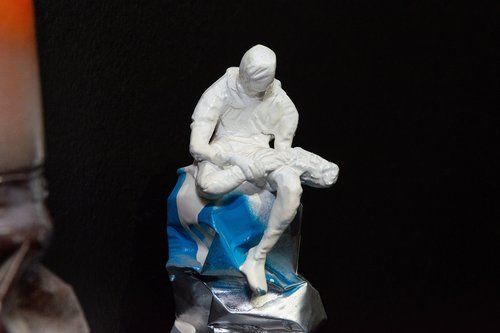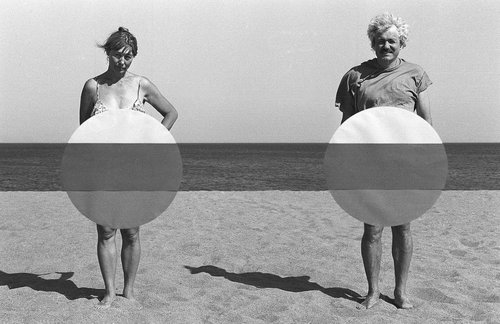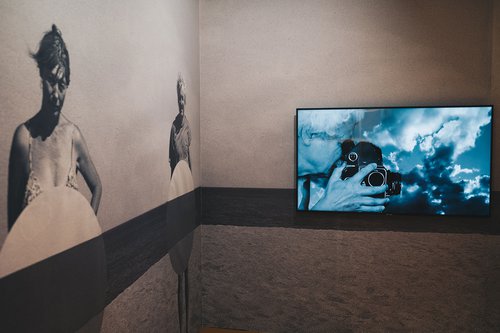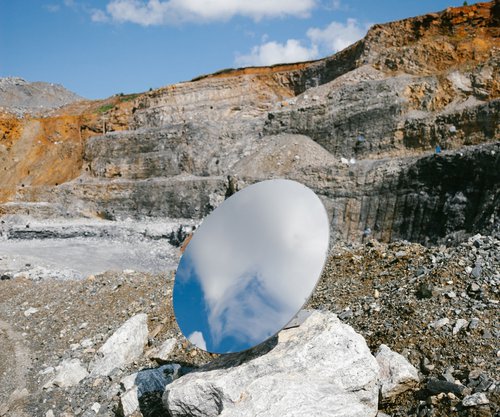Francisco and Platon Infante's Celestial Artefacts on the Prospekt. 2024. Photo by Daniel Annenkov. Courtesy of GES-2 House of Culture
All Smoke and Mirrors: Artists Who Play with Your Reflection
Artists love using mirrors to captivate their audiences and blend self-reflection with illusion. In today’s Russia, these reflective works of art invite viewers to confront identity, space, and even spirituality in the most unexpected of ways.
Art made from mirrors is bound to always attract attention wherever it is, as the temptation to stare at our own face is irresistible, even if we hate our appearance. A decade ago art fairs were flooded by Michelangelo Pistoletto’s mirror paintings and after a few years came Anish Kapoor’s round and shiny mirrors evoking fairground illusion rooms. Speaking of rooms, Yayoi Kusama’s ‘Eternity Rooms’ were so popular all over the world, that people queued for hours to get inside them and take selfies. In the depressing moral climate of Russia today, with censorship and self-censorship proliferating in the art world, not only radical political messages but almost any artwork addressing gender, religious or national identity cannot be displayed in the nation’s institutions or public spaces. It is no surprise that abstract pieces and introspective works focusing on human emotions now dominate exhibition halls. Artists look intensely at themselves, questioning their place in the shocking and absurd reality, and invite the audience to do the same, sometimes literally. Hence, mirror-based works have come into fashion, although many artists have been creating them for years.
Both Pistoletto and Kapoor question the role of the spectator and challenge the conventions of ‘looking at art’, by incorporating the viewer's reflection into their artworks. Some artists in Russia have adopted the same approach such as Annouchka Brochet (b. 1967), whose solo exhibition is now on view at the Moscow Museum of Modern Art. Mirrors adorned with what look like prints of oversized lipstick-covered sensuous lips, with dripping streaks of paint, have been her staple for decades. Now this kitschy take on femininity has acquired horror-film undertones. Unsuspecting visitors look into the mirror and see a vampire’s mouth dripping with blood that sticks to the viewers’ faces.
On the contrary, Sergei Shekhovtsov (b. 1969) focuses on frames, rather than the mirrors themselves in his ‘Frames and Paintings’ project, first shown to the public at Elohovskiy Gallery’s booth at Cosmoscow. Filled with references to art history, from the Dutch Golden Age to Piet Mondrian, it is a brave take on the deconstruction of painting as a medium. The image spills from the absent canvas out to the frames. They are turned into opulent sculptural still-lifes with fruits and sea creatures. Yet these lavish frames surround a blank space, an emptiness, a void: a mirror. The lifeless white hue of the frames which are moulded out of plastic adds up to a strange effect – the impression of a dummy, an illusion of abundance, with hollowness in the middle, where viewers suddenly come face-to-face with themselves.
Many artists use mirrors to challenge our perception of space and create optical and spatial illusions. For many decades, Francisco Infante-Arana (b. 1943) used mirrors and analog photo cameras to create his Artifacts, ‘impossible’ compositions in real landscapes, inspired by the geometric abstractions of the Russian avant-garde. Co-authored with his wife Nonna Goryunova (b. 1944), these works have become iconic pieces of non-conformist art. However, after the invention of digital photography and Photoshop, the masterful elegance and visual ingenuity of his experiments was undermined by the fact that similar effects could be easily created by simple digital tools. So Infante turned to 3D objects with reflective surfaces that could create striking spatial effects not just on film but in the real world. His stainless steel sculpture ‘Life of the Square’ hides in the lush greenery at Malevich Park near Moscow, reflecting bits of sky and foliage. At a current exhibition in GES-2, Infante has created enormous kinetic installations together with his son Platon (b.1978), works that expand the visual game of reflections to epic proportions. The huge space of the main hall at GES-2, with its industrial architecture, painted in otherworldly white, looks like a sci-fi film set. Rotating creations by father and son add action and mystery to this sterile environment, reflecting random fragments of architecture from different angles.
Millennial artist Vassily Kononov-Gredin (b. 1990) has also been thinking big. He has turned an abandoned quarry into a piece of land art with a ‘Rock Garden’ installation in the industrial town of Satka where he placed 250 round mirrors on walls and ledges. They reflect sunlight into the dark quarry and on the surface of water which gradually fills the pit once the pumps have stopped. When the pit will be full of water the mirrors will be submerged forever, a rather obvious hint at the futility of human endeavour in general and art in particular. This project has been criticized for lack of consideration of the environment as birds can become confused by the mirrors and crash into them. Tatiana Badanina (b. 1955), another master of optical illusions, attempts to convey spiritual messages, by creating ‘endless’ ladders with Christian values inscribed on their steps. Her installation ‘Stairway to Heaven’, re-created several times in different locations, seems to stretch into eternity due to mirrors which are placed on the top and bottom. However, at a closer look, an unexpected second meaning emerges: a cynical onlooker might conclude that spiritual progress is merely an illusion.
Any big trend in art is bound to spread from the walls of a museum to the museum shop. Elena Krylova, founder and curator of retail chain and gallery Artmag which sells arty souvenirs, jewellery and clothes, has collaborated with several artists to create a collection of mirrors. The result is a quirky hybrid of contemporary meme culture and Moscow Conceptualist traditions of text-based art. Mirrors of all shapes and sizes are decorated with ironic images and witty inscriptions such as ‘I Feel Good with Myself’ by Andrey Logvin (b. 1964) or ‘My Ego Looks at Me from Here’ by Mikhail Rubankov (b. 1983). A selfie addict’s paradise – or a desperate call for much-needed reflection, for those who can hear.
Annouchka Brochet. Pandora. Unpacking
Moscow, Russia
7 November – 8 December, 2024
Celestial Artefacts
Moscow, Russia
19 September, 2024 – 2 March, 2025



















